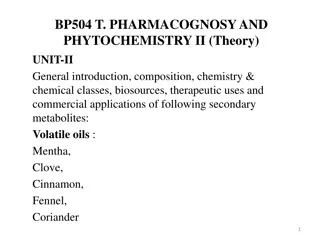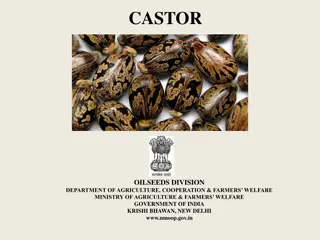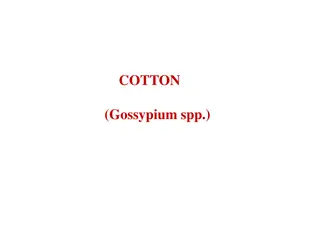Overview of Soybean: Cultivation, Importance, and Economic Benefits
Soybean (Glycine max L.) is a significant oilseed crop with high protein content, originating in China and spreading globally. It is a versatile crop with economic importance in various industries such as food, oil extraction, and animal feed. With special features like being a cost-effective source of vegetable protein, soybean plays a crucial role in meeting nutritional demands and contributing to agricultural economies. Its adaptability to different climates and ability to serve as an intercrop make it a valuable crop for farmers worldwide.
Download Presentation

Please find below an Image/Link to download the presentation.
The content on the website is provided AS IS for your information and personal use only. It may not be sold, licensed, or shared on other websites without obtaining consent from the author. Download presentation by click this link. If you encounter any issues during the download, it is possible that the publisher has removed the file from their server.
E N D
Presentation Transcript
Soybean (Glycine max L.) is a member of family Leguminosae, 2n=40. Other nomenclatures which have been used for soybean are Phaseolus max, Soja max and Soja hispida. Indian names for Soybean are bhat, bhatman, bhatmas, kulthi, ramkulthi, bhut, kalitur, teliakulth and gerakalay. Major oilseed crop in world; accounts for 15% of total oilseed production in India as well as in world. It provides 60% of vegetable protein and 30% vegetable oil in the world. Soybean ranks in third in India, in oil economy after groundnut and rapeseed and mustard.
Origin and distribution Cultivated soybean was originated in China during 2800 BC. Eastern half of Northern China is believed to be the primary centre and Manchuria is believed to be secondary centre of soybean. From there it has spread to Korea and Japan and later has introduced to USA and Europian countries during 17th century. It was introduced to India during seventies of 20th century. Soybean with its 40% protein and 20% oil holds great promise in meeting protein requirement of growing population.
Special features of soybean It is the cheapest source of vegetable protein. Quality of soybean protein is equal to meet, milk and egg. Fortification of wheat flour with soyaflour doubles the nutritional aspect of bread without any changes in flavour and price. Meat, poultry, egg and milk products are more expansive compare to soya protein.
Economic importance of Soybean Soybean plants are used as fodder. Oil is used in the preparation of glycerine, explosive, varnishes, paints, soaps, celluloids, soyalecithin and vitamin E. Seed is used in soy beverage, soy curd, soy milk, soy ice cream, soy candy, wheaning foods, soy malts, soy cheese and nutri nuggets. Soy cake which is obtained after oil extraction. It is having lot of export value and earns good foreign exchange to India.
Soybean prepares well as intercrop as well as mixed crop and it is usually mix with maize in Northern plains and mixed with pearl millet, sorghum pigeonpea and cotton in Central India. Common with ragi and sugarcane in South India. Soybean can tolerate mild drought as well as floods and survives better than maize. It is able to leave residual nitrogen effect for succeeding crop i.e 35- 40 kg N/ ha.It provides good coverage to soil so that crop can be protected from rains and winds and counteracts soil erosion. In 1963-1964, Mr.Edvin Bay introduced some soybean varieties for experiment at Pantnagar and Jabalpur. The climate was found to be suitable.
In early periods crop failed to make its impact on Indian agriculture, primarily because of 1. Poor acceptability of black seeded varieties 2. Low yielding and disease susceptible varieties 3. Long duration of maturity and viny growth 4. Shattering of grains 5. Main source of utilization, namely industry did not exist 6. Lack of appropriate link between growers and processors 7. Lack of awareness about benefits of soybean and soy products 8. Lack of appropriate product development utilization and marketing
Depending on form, size, shape and colour soybean is classified into different types. I. Manchurian classification a) Based on colour of seed coat Group A: Yellow group (Yellow seeds with light coloured hilum) Group B: Black group (Black seeds with golden coloured hilum) Group C: Green group (Green seeds with brown coloured hilum) b) Black group 1. Large black seeds 2. Flat black seeds 3. Small black seeds c) Green group 1. Epidermis is green but embryo is yellow in colour 2. Both epidermis and embryo are green in colour
Martins classification Based on shape of soybean seeds i) Soya elliptica: Egg shaped seeds ii) Soya spherical: Round seeds iii) Soya compress: Pressed seeds
Botany Cultivated soybean is annual, generally exhibiting erect, sparsely branched, bunch type growth habit with pinnately trifoliate leaves, purple or white colour flowers born on axillary raceme on reduced peduncle. Pods are slightly curved and they are hirsute. Plant varies in height from 0.2 to 2 metres. Branching depends on cultivation methods, season of cultivation etc. The mature soybean plant will have 18 to 24 nodes, the leaf nodes is point of attachment to the cotyledons. Next nodes give rise to opposite unifoliate leaves. Subsequent nodes produce single trifoliate leaves but arranged in alternate manner. Pods are covered with numerous hairs.
Floral primordial initiation takes place after 3 to 4 weeks after seed emergence. Pods are visible in one and half weeks after onset of flowering. Flowering continues for three to four weeks. Many stages of pod and seed development observe in soybean until physiological maturity of crops. Flowers are papeionaceous on short axillary, baring 30 to 35 flowers in clusters. Pods are slightly curved and they are hirsute. Usually pods contain 3 to 4 seeds. Seeds in all pods mature in period of one week even though pollination time varies greatly.
Types of leaves observed in soybean 1. Cotyledons / seed leaves These are semicircular in shape. These leaves will have stomata on both upper and lower side and turn yellow and drop from plant during early vegetative growth 2. Primary / unifoliate leaves These are opposite and borne on node immediately above the cotyledonary node. They have 1-2 cm long petioles and pair of stipules are attached at the point of attachment of stems. 3. Trifoliate leaves Produced on main stem as well as in the branches and they are arranged in alternate fashion but they are trifoliate leaves. Leaflets of trifoliate varies 2-4 cm length and 3-10 cm breadth. 3. Prophyllous leaves These are small and simple leaves. Occurs at the base at each lateral branches and lower part of peduncle of each flower, lack petiole and they are pubiscent.
Soybean was first characterised to have tap root system with many branches penetrates to a depth of 150 cm and major portion of depth increases faster than shoot height during vegetative development. Root depth is almost twice the length of shoot height. This kind of proportion is seen upto to reproductive stage. Eventhough root depth exceeds shoot length. Dry weight of shoots is always more than dry weight of roots. Nodule initiation takes place once they are infested by Bradyrhizobium japonicum and also infested by gram negative rod shaped bacteria. Roots secretes substance which promotes rapid growth of soil moisture including rhizobium. It is self pollinated crop with complete flower. Stigma is receptive a day before pollen shedding by same flower.
Distribution, area and production Soybean is grown in 97.7 m ha in world. World production is 200 mt. USA tops in acreage and production. Other countries are Brazil, China, Argentina, India, Indonesia, Canada and Italy. India has 9.8 m ha area, Production is 9.91 mt. Productivity of soybean in India is 1300 kg/ha. It ranks fifth after USA, Brazil, China and Argentina. Soybean contributes 25-30% India s oilseed production. M.P produces nearly 70% of total production followed by Maharashtra and Karnataka.
Climate and Soil Soybean is short day plant. Optimum temperature for growth is 30 C. Temperature more than 18 C does not permit pod set. Seed is largest when plants are grown at 27 C and numbers of pods per plant are maximum at 30 C. Temperature more than 24 C delays flowering by 2-3 days for each increment of 0.5 C. Floral induction is generally inhibited by temperature 10 C and below. Heat stress at 40-46 C also results in pod abscission. Soybean plants are more tolerant to anaerobic condition i.e. tolerate plant elongation of roots and are not restricted until root zone oxygen dropped below 10%. Soil pH of seven with fair degree of water retension capacity is suited for cultivation. Grows well in sandy loam to clay loam.
Land preparation For better seedling establishment there should be sufficient moisture at the time of sowing. As a leguminous crop it requires fine seed bed with less clods. To achieve this deep ploughing discing followed by two harrowing are necessary. Minimum tillage is also advantages and also practiced in large area.
Time of sowing Early planting is advantageous as it put forth canopy. But photoperiod, occurrence of drought and flood will decide date of sowing. In Indian condition soybean is usually rainy season crop and is sown in June last week and up to July end and August to October. However in irrigated area spring soybean is also raised and sown from January 15th to March 15th.
Five zones identified in India for soybean cultivation 1. North hill zone: last week of May to June end 2. Northern plain: mid june to first week of july 3. Central zone: Mid june to mid july 4. Southern: kharif : Mid june to july end Rabi Summer 5. North East zone: Mid june to july end : 1st week of October to December : 2nd fortnight of January If irrigation facilities are available pre-sowing irrigation in given in 2nd and 3rd zone and crop can be sown in last week of June. Planting time is decided in such a way that there should not be rain either during planting time or during pod ripening time. Optimum spacing for kharif crop: 45 45 cm Spring crop: 30 3 - 4 cm
Depth of planting Depth of 2.5 to 4 cm is optimum for soybean sowing. Shallow depth is justified in areas of crust formation. Deep soil placement is suggested in sandy soil. Seed rate It depends on test weight, variety, germination percentage and season of cultivation. Wider spacing is given in kharif season. More seed rate is used in summer. 70 - 80 kg is used in kharif and 100 kg in summer. However a population of 4 lakh plants per hectare is recommended.
Fertilizer management Soybean responds well to nutrients. But increase in yield from 4 to 7 tons/ha the nutrients need will drastically change. In most of soybean growing area less P and K applied than recommendation. Uptake of NPK is rapid during pod filling stage. The uptake in such peak periods may exceeds 12.5 kg N, 1.2 kg P and 10 kg /ha/day. Soybean crop yielding 4 tons/ha will remove 40 kg P, 130 kg K, 90 kg Ca, 40 kg Mg and 8 kg S /ha. Role of nitrogen and its management Nitrogen deficiency results in flower and pod abortion and leaves turn pale green to yellow. Large amount of nitrogen reduces root hair infection, nodule mass, nitrogen fixation capacity and total nitrogen fixed. Number of nodules is inversely and linearly related to the amount of nitrogen applied because this is nitrate sensitivity of nitrogenase enzyme. There will be simultaneous reduction of C and N. Limited C assimilation restricts N assimilation and vice versa, thus affecting grain yield.
Phosphorus This has role in ATP synthesis, nodule development and nitrogen fixation. Percent of P in plant derived from fertilizer is inversely related to level of soil P and directly related to rate of P applied. For normal crop of soybean use of 60.80 kg P2O5 /ha and entire quantity of P applied at time of planting is recommended. For better nodulation soybean requires potassium is 40 kg K2O/ha and supplied at basal dose. At K deficient condition crop maturity going to delay and seed quality also reduced. In case of severe deficient condition foliar spray of 0.5% concentration 2 to 4 times at interval of 10 days. Potassium For better nodulation soybean requires potassium application @ 40 kg k2O /ha as basal application.
Sulphur Being oilseed crop soybean show more response to sulphur. In sulphur deficient soil 20 kg S/ha supplied preferably through gypsum. Zinc Deficiency of Zn in high rainfall upland area and in sodic soil. Such situations add 5 kg Zn by ZnSO4. Addition of 5 kg zinc can increase the yield up to 40-45%.
Weed management Weed control in soybean is accomplished using intercultivation and herbicides. Crop rotation helps in reducing weed intensity in soybean. To avoid critical weed competition in early growth period weed free period of 30-40 DAS is needed. Hand weeding at 20-25 DAS and at 40-45 DAS. Soybean respond well to herbicides like fluchloralin @ 1 kg a.i /ha, Alachlor 2 kg a.i /ha, Metalachlor 1 kg a.i /ha as preplant application. Post emergent application of Imazethapyr @ 75-80 g/ha and Quizalofopethyl @ 50 g/ ha is also done.
Water management Soybean is mainly cultivated in rainy season. But supplemental irrigation is necessary if dry spell is prolonged. Moisture stress at pod filling is more sensitive but losses in grain yield is less than other crops because soybean has extended flowering period because pod matures at different stages. Water stress during grain filling stage reduces seed size. Avoid flooding at any stage. Flooding at floral initiation retards nodule and flower initiation. In kharif water is not needed. In summer, crop is grown only under irrigation. It needs 5-6 irrigations. To achieve good yield, water is needed at sprouting, pod initiation and pod filling.
Harvesting and threshing When pods become golden yellow and black crop is ready to harvest. At harvest, moisture content of seed should be 15-17%. Maturity period ranges from 90-120 days. When holdings are small manual harvesting by cutting at ground and threshing is done with mechanical threshers or conventional threshers. Threshing should be done carefully and severe beating and trampling will result in loss of seed quality and germinability of crop. Soybean can be threshed with wheat thresher but some change like cylinder speed should be reduced to 300-400 rpm and fan speed as to be increased. Seed moisture of 13-15% is ideal for mechanical threshing. Yield potential of good quality crop is 20-25 quintals in irrigated area and under high input management yield can go up to 30 quintals.
Drying and storage To maintain longer storage seed moisture should be 10%. Hot air speed driers used in large farms and temperature should not exceed 40 C. Seed for sowing purpose is stored in tin cans, jars, polythene bags and gummy bags. Moisture proof condition is common. Air condition and storage at 10-20 C and more than 60% RH is suggested to avoid fungal contamination.























